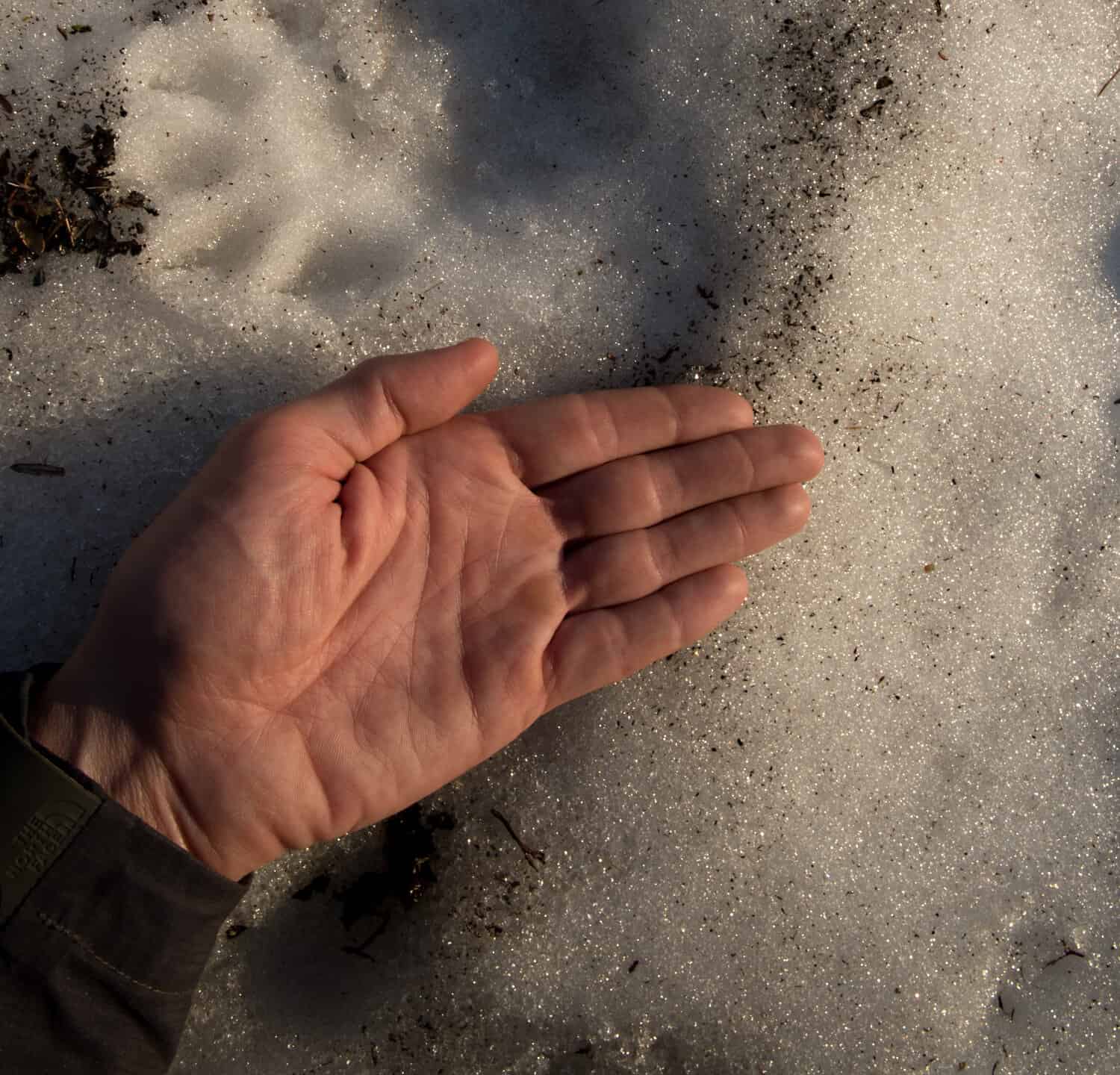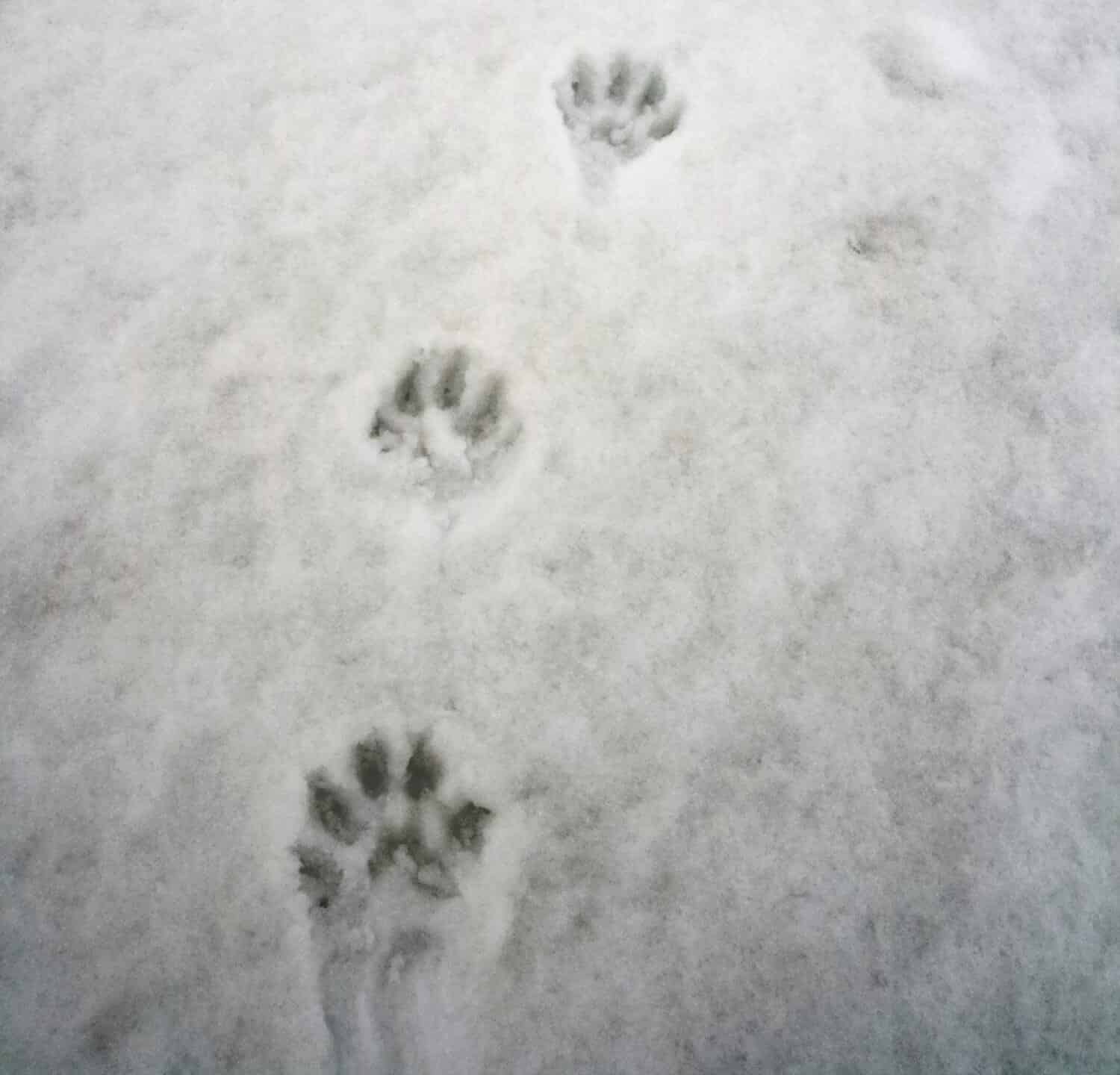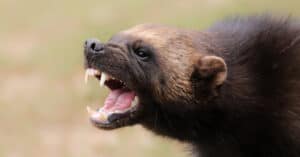Wolverine tracks stand out due to their large size and shape. This is because they move in a unique manner. For example, wolverines create paired tracks because they sometimes jump. However, they also gallop, which creates a diagonal line from imprints of three. Their footprints have five toes, unlike wolf or lynx tracks, with only four toes. Furthermore, they have triangular tracks that become narrower towards the heel. Their toes leave clearly visible impressions because they curve on the paw’s pad, looking almost like a semi-circle.
Wolverine tracks are not the only way to tell if this mysterious creature is in the area. There are a few other signs that alert one to their presence, like scat or carcasses. However, whatever you may find, it’s essential that you document it thoroughly because wolverines are so rare, and sightings are uncommon.
What is a Wolverine?
The wolverine is the biggest land-dwelling species of the Mustelidae family. They are muscular omnivores who lead solitary lives. But, like their vicious cousins, the honey badger, wolverines have a bad reputation for ferocity and strength. For example, they can kill animals much larger than themselves.
Regarding appearance, wolverines have characteristics similar to a bear, a skunk, and a dog. As a result, they have short legs, long snouts, and long hair. While their legs aren’t very long, they are stocky. In addition, the five toes on their paws have crampon-like claws, and posture helps them to climb up trees, cliffs, and mountain peaks with almost no effort. In addition, they have dark, thick, highly hydrophobic, and oily fur, making them frost resistant. Therefore, these rare animals prefer colder climates and occur in the Alpine forests, grasslands, tundra, taiga, boreal forests of Europe, the Arctic and subarctic, northern parts of North America, and Asia. They inhabit boreal forests, mountainous areas, alpine tundra, and subarctic.

Regarding appearance, wolverines have characteristics similar to a bear, a skunk, and a dog.
©Ondrej Prosicky/Shutterstock.com
Identifying a Wolverine Track
Wolverine tracks often have five-toe imprints. However, the fifth toe is not always present. Their prints are typically 31. Inches to 3.9 inches in width, and their metacarpal print and claws measure 3.9 to 4.7 inches. Furthermore, they have a triangular inter-digital pad, and their metacarpal print is not always visible. Their tracks usually come in two types of patterns, two-by-two or three-by-three imprints.

Wolverine tracks often have five-toe imprints. However, the fifth toe is not always present.
©Lexleshiy RF/Shutterstock.com
Wolverine Tracks in the Snow
When in the snow, the wolverine generally uses the two-by-two pattern, which is very similar to the pine marten paw print. This pattern is also often used when running.

When in the snow, the wolverine generally uses the two-by-two pattern
©Okyela/Shutterstock.com
Wolverine Tracks in the Mud
Because wolverines prefer colder climates, it’s very rare to see their tracks in the mud. But, when they do walk over mud, their prints are typically four inches long. In addition, their claw imprints are usually visible. Both fore and hind feet tracks show four, sometimes five, toes. Lastly, their heel is shaped like a triangle. Because these mysterious animals live in the high mountain wilderness, they are active all year long, as they do not hibernate.
What to Do When You Find a Wolverine Track
If you happen to come across a wolverine track, the first thing you need to do is note the date and time. Next, find your location on a map; it needs to be as accurate as possible, so try using a GPS point. Then, take pictures of the gait patterns (two-by-two or three-by-three) using a scale like a glove, pen, or hand. Once you are done taking photos, measure the tracks and the distance between them. Then, describe the prints. For example, are there droppings, holes in the snow, and the direction of travel. Lastly, take note of your surroundings. Try to find discarded carcasses. Alternatively, check for any signs of wildlife in the surrounding areas.
Other Signs of a Wolverine
There are several signs a wolverine is in the area. First, as they are skilled climbers, their claws can leave marks on the tree trunks (mainly pines). Furthermore, from February to March, females will dig caves in the snow where they give birth.
Secondly, when the weather is favorable, these small critters can hunt and successfully kill several reindeer in a short time period. When wolverines hunt reindeer, they attack from behind and jump on its back. Next, they bite the deer in its withers and behind the neck. Therefore, any deer carcass should have noticeable holes and contusions on the back of its neck and on its back. Additionally, wolverines are major scavengers, so they often find carcasses of animals killed by other predators. So, finding a predator killed by the wolverine over prey is possible.
Scat
If there is a wolverine in the area, it will mark its territory by defecating, biting, and urinating on pine and spruce saplings. Their droppings vary depending on what they’ve eaten. For example, it could be dark due to hair or bone fragments. However, they are typically shaped like a sausage, thick on one end and narrow on the other. Lastly, their droppings are usually an inch long.
Carcasses
As mentioned above, you can tell if a wolverine has killed an animal, but spotting their carcasses doesn’t happen often because the wolverine generally hides their food in the snow. They use it like a refrigerator and depend on their stash during the colder months after their offspring are born. It’s a clever technique because other scavengers won’t find it, and it keeps bacteria and insects away. Wolverines feed on nearly everything, including:
- Ground squirrels
- Mountain goats
- Bird’s eggs
- Moose
- Reindeer
- Berries
Researchers have observed wolverines hiding their food in captivity and in the wild. Making caches of food is the only way their young can survive, as females give birth in late winter.
Wolverine Conservation Status
While their numbers are declining, the wolverine is listed as “Least Concern” on IUCN’s Redlist. However, the European species are listed as “Vulnerable,” with a population of 15,000 to 30,000 individuals. Unfortunately, the wolverines biggest threat is climate change. This is because they depend on the snow to store food and reproduce. But, humans also pose a threat, as hunters target them for their fur, which is desired for its frost-resistant abilities. However, they have predators too, which include
- Black bears
- Golden eagles
- Mountain lions
- Brown bears
- Wolves
Animals Similar to the Wolverine
Wolverines belong to the family Mustelidae which occur in aquatic and terrestrial regions throughout the globe except for Antarctica, Australia, and most Oceanic islands. Here are animals who belong to the same family and are very similar.
Honey Badger
The honey badger has a reputation as a fighter. They show no fear, and people have seen them attacking buffalo and lions in defense. Humans aren’t safe either; they deliver a powerful bite and don’t let go. Additionally, their loose skin allows them to wriggle out of the strongest grasp. These intimidating tanks feed on prey like honey, fruit, eggs, larvae, grubs, and reptiles. They have a mutually beneficial relationship with the honeyguide bird. The honeyguide leads the honey badger to beehives in exchange for a share of the bounty.
Polecats
The polecat is currently recovering from the verge of extinction and inhabits rural areas of Whales and England. They prefer habitats like marshes, lowland wooded areas, farm buildings, and along riverbanks. Their favorite prey is rabbits, and they are often found in rabbit burrows.
Weasels
The weasel is Britain’s smallest carnivore and the smallest species in the Mustelidae family. They have a wide range and occur in:
- Western and Central Europe
- North Africa
- Mediterranean region
- North America
- Introduced to New Zealand
The photo featured at the top of this post is © Jarno Holappa/Shutterstock.com
Thank you for reading! Have some feedback for us? Contact the AZ Animals editorial team.





